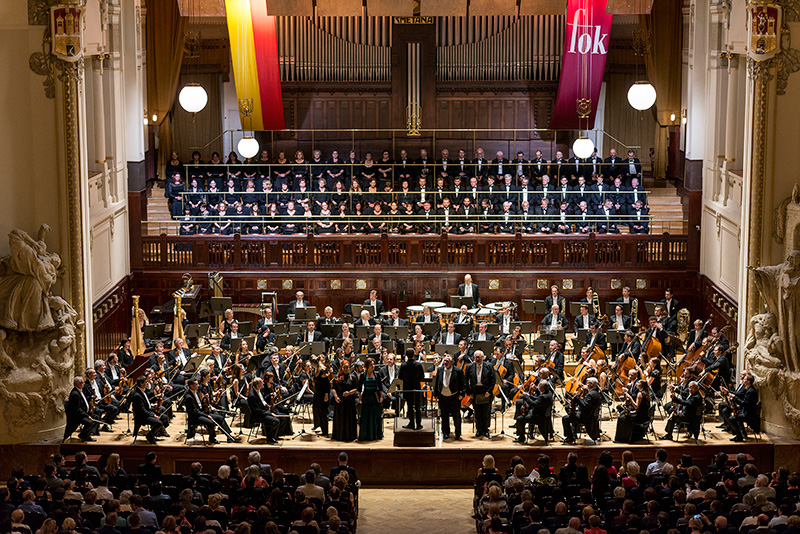The Prague Symphony Orchestra are in town, their Cadogan Hall concert the London leg of a UK tour. It’s ambitious, including Mahler’s epic Third Symphony in five different cities, each with a local chorus. The orchestra itself, Prague’s second band, is a spirited and distinctively Central European ensemble. And they have an interesting conductor, the young Finn Pietari Inkinen, who, since taking charge of the Prague Symphony in 2015 has also added Saarbrucken and Tokyo orchestras to his portfolio, and was recently named as the conductor for Bayreuth’s new Ring cycle next year.
Cadogan Hall isn’t ideal for such a huge orchestra, and the players sprawled out under the side balconies and well into the auditorium on temporary stage extensions. The two choirs, the Tiffin Boys’ Choir and the ladies of the Brighton Festival Chorus, were positioned in the balconies above, and everything was a squeeze. Acoustically, it just about worked, although there was nowhere to hide in the quietest passages, which lacked mystery when we could hear every bow stroke, and the climaxes often overwhelmed – and not in a good way (pictured below: the Prague Symphony Orchestra in its much more spacious home in Prague, the Smetana Hall).  Inkinen is a dynamic conductor, and his tempos rarely stay fixed for long. That made the first movement seem choppy and episodic – which it is, although other conductors make efforts to hide the fact. Some distinctive woodwind and brass playing brought Czech flavour. The narrow-bore trumpets sang out their fanfares, with just a hint of vibrato. The trombone solo, from Jiří Novotný, was suitably brassy, if a little angular. Strangest of all was the principal horn, who sported a bandana and writhed uneasily in her seat. Her solos were excellent, but she treated every small grouping as if she was in charge, applying rubato and dynamic swells as she saw fit. I wonder what the rest of the orchestra makes of her.
Inkinen is a dynamic conductor, and his tempos rarely stay fixed for long. That made the first movement seem choppy and episodic – which it is, although other conductors make efforts to hide the fact. Some distinctive woodwind and brass playing brought Czech flavour. The narrow-bore trumpets sang out their fanfares, with just a hint of vibrato. The trombone solo, from Jiří Novotný, was suitably brassy, if a little angular. Strangest of all was the principal horn, who sported a bandana and writhed uneasily in her seat. Her solos were excellent, but she treated every small grouping as if she was in charge, applying rubato and dynamic swells as she saw fit. I wonder what the rest of the orchestra makes of her.
The string sound was rich but sometimes lacked security. That was a shame, because one of Inkinen’s great strengths is creating magical moments out of quiet episodes or mood changes. So when Mahler cuts off the orchestra and introduces a new theme in the cellos and basses, for example, Inkinen makes a real feature of it, but the players don’t quite give him the precision he needs to pull it off.
Inkinen began the second movement in a stately fashion – a dance, though hardly a rustic one – but soon raised the temperature, with a series of huge, kaleidoscopic climaxes, the tempos fast and variable, an exhilarating but often disorientating effect. The third movement coped better with Inkinen’s adrenaline-fuelled drive, the tuttis here clothed in more elaborate orchestral effects. And he held everything back beautifully for the off-stage post horn, beautifully played (on a trumpet) by Marek Zvolánek.
 Mezzo Ester Pavlů (pictured left) was a welcome new arrival on the London stage for her fourth movement solo, the eerie setting of Nietzsche’s “Midnight Song”. Her voice projects effortlessly, and her German diction is excellent, but her tone was a little lacking in character and colour, especially in the top register. Inkinen, too, struggled to make this movement evocative or atmospheric, a surprise given how often he achieved similar effects in the earlier ones. The choirs both sang well in the fifth movement, although facing the orchestra rather than the audience diminished their volume.
Mezzo Ester Pavlů (pictured left) was a welcome new arrival on the London stage for her fourth movement solo, the eerie setting of Nietzsche’s “Midnight Song”. Her voice projects effortlessly, and her German diction is excellent, but her tone was a little lacking in character and colour, especially in the top register. Inkinen, too, struggled to make this movement evocative or atmospheric, a surprise given how often he achieved similar effects in the earlier ones. The choirs both sang well in the fifth movement, although facing the orchestra rather than the audience diminished their volume.
One more magic moment from Inkinen, the seamless transition from the ebullient fifth movement to the serene finale, the move handled perfectly and with ideal timing. The finale itself was taken a little faster than usually, but this had the effect of shaping the long string phrases more clearly. The early climaxes were again regularly whipped up to frenzy, the conductor momentarily forgetting all about the Langsam-Ruhevoll (Slow-Tranquil) tempo marking. But the orchestra raised their game here, with some particularly elegant and controlled playing, especially from the woodwind soloists. Inkinen is clearly a versatile conductor, and Mahler’s Third gives opportunities to demonstrate all sorts of textures and moods. And, despite some overwrought climaxes early on, this last movement had many moments of depth and beauty. Inkinen made it the soul of the symphony – just as it should be.















Add comment